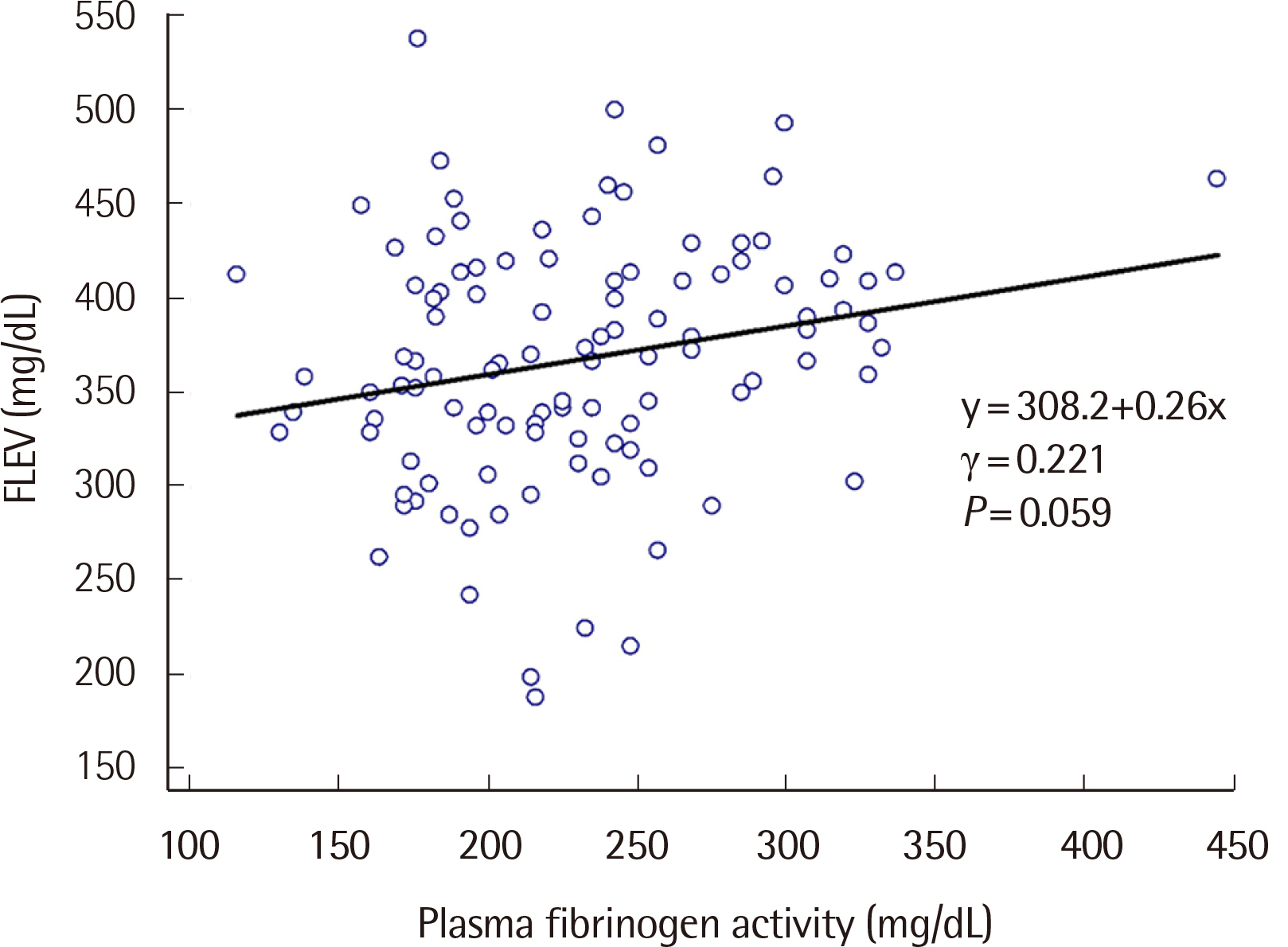Lab Med Online.
2022 Apr;12(2):109-115. 10.47429/lmo.2022.12.2.109.
Influence of Blood Coagulation Factors on Thromboelastographic Parameters in Healthy Adults
- Affiliations
-
- 1Department of Laboratory Medicine, Seoul National University Hospital, Seoul, Korea
- 2Cancer Research Institute, Seoul National University College of Medicine, Seoul, Korea
- KMID: 2538593
- DOI: http://doi.org/10.47429/lmo.2022.12.2.109
Abstract
- Background
Thromboelastography (TEG) is a method that assesses whole-blood coagulation efficiency by measuring different parameters of clot formation and clot lysis. Whether and how blood coagulation factors influence the TEG parameters is unknown.
Methods
Blood coagulation factors measured by an automated coagulation analyzer (ACL TOP; Beckman Coulter, USA) and thrombin generation measured by automated thrombogram method (Thrombinoscope, Netherlands) were quantified in 109 healthy volunteers to investigate their correlation with six TEG parameters. TEG parameters were analyzed with the TEG 5000 Hemostasis Analyzer System (Haemonetics, USA). To assess whether TEG detects coagulation factor deficiencies, TEG was performed in four patients, with three known coagulation factor deficiencies.
Results
Reaction time negatively correlated with factors V and XII, and clot formation time positively correlated only with factor XII. Alpha angle positively correlated with factor XII and negatively with protein S. Maximum amplitude showed a positive correlation with fibrinogen and factors VIII and XII, whereas coagulation index only with factors VIII and XII. Thrombin generation and percentage of fibrinolysis at 30 minutes after maximum amplitude exhibited no correlation with the TEG parameters. Of the four TEG-tested patients, only the patient with factor V deficiency had elevated reaction time values.
Conclusions
TEG parameters, especially reaction time, are mainly affected by factors V and XII. Since TEG had limitations in detecting coagulation factor deficiencies, future research should improve its sensitivity with various stimuli that activate coagulation factors.
Figure
Reference
-
1. Chitlur M. 2012; Challenges in the laboratory analyses of bleeding disorders. Thromb Res. 130:1–6. DOI: 10.1016/j.thromres.2012.03.011. PMID: 22483776.
Article2. Othman M, Kaur H. 2017; Thromboelastography (TEG). Methods Mol Biol. 1646:533–43. DOI: 10.1007/978-1-4939-7196-1_39. PMID: 28804853.
Article3. Müller MC, Meijers JC, Vroom MB, Juffermans NP. 2014; Utility of thromboelastography and/or thromboelastometry in adults with sepsis: a systematic review. Crit Care. 18:R30. DOI: 10.1186/cc13721. PMID: 24512650. PMCID: PMC4056353.
Article4. Tran HT, Tjønnfjord GE, Holme PA. 2014; Use of thromboelastography and thrombin generation assay to predict clinical phenotype in patients with severe FVII deficiency. Haemophilia. 20:141–6. DOI: 10.1111/hae.12256. PMID: 23992369.
Article5. Spiezia L, Radu C, Campello E, Bulato C, Bertini D, Barillari G, et al. 2012; Whole blood rotation thromboelastometry (ROTEM®) in nine severe factor V deficient patients and evaluation of the role of intraplatelets factor V. Haemophilia. 18:463–8. DOI: 10.1111/j.1365-2516.2011.02710.x. PMID: 22176523.6. Nascimento B, Al Mahoos M, Callum J, Capone A, Pacher J, Tien H, et al. 2012; Vitamin K-dependent coagulation factor deficiency in trauma: a comparative analysis between international normalized ratio and thromboelastography. Transfusion. 52:7–13. DOI: 10.1111/j.1537-2995.2011.03237.x. PMID: 21745216.
Article7. Lowe GD, Rumley A, Mackie IJ. 2004; Plasma fibrinogen. Ann Clin Biochem. 41:430–40. DOI: 10.1258/0004563042466884. PMID: 15588432.
Article8. Clinical, Laboratory Standards Institute. 2010. Defining, establishing, and verifying reference intervals in the clinical laboratory; approved guideline-Third edition. CLSI document EP28-A3c. Wayne, PA: Clinical and Laboratory Standards Institute.9. Chen A, Teruya J. 2009; Global hemostasis testing thromboelastography: old technology, new applications. Clin Lab Med. 29:391–407. DOI: 10.1016/j.cll.2009.04.003. PMID: 19665684.
Article10. Kim SY, Kim JE, Kim HK, Kim I, Yoon SS, Park S. 2013; Influence of coagulation and anticoagulant factors on global coagulation assays in healthy adults. Am J Clin Pathol. 139:370–9. DOI: 10.1309/AJCPC5C4AGFRDKMX. PMID: 23429374.
Article11. Choi Q, Kim JE, Kim SY, Han KS, Kim HK. 2015; Influence of ABO type on global coagulation assay results: effect of coagulation factor VIII. Clin Chem Lab Med. 53:1425–32. DOI: 10.1515/cclm-2014-0909. PMID: 25503670.
Article12. Macafee B, Campbell JP, Ashpole K, Cox M, Matthey F, Acton L, et al. 2012; Reference ranges for thromboelastography (TEG®) and traditional coagulation tests in term parturients undergoing caesarean section under spinal anaesthesia*. Anaesthesia. 67:741–7. DOI: 10.1111/j.1365-2044.2012.07101.x. PMID: 22486761.
Article13. Scarpelini S, Rhind SG, Nascimento B, Tien H, Shek PN, Peng HT, et al. 2009; Normal range values for thromboelastography in healthy adult volunteers. Braz J Med Biol Res. 42:1210–7. DOI: 10.1590/S0100-879X2009001200015. PMID: 19882085.
Article14. Polak F, Kolnikova I, Lips M, Parizek A, Blaha J, Stritesky M. 2011; New recommendations for thromboelastography reference ranges for pregnant women. Thromb Res. 128:e14–7. DOI: 10.1016/j.thromres.2011.04.007. PMID: 21543108.
Article15. Bleker SM, Coppens M, Middeldorp S. 2014; Sex, thrombosis and inherited thrombophilia. Blood Rev. 28:123–33. DOI: 10.1016/j.blre.2014.03.005. PMID: 24768093.
Article16. Moores L, Bilello KL, Murin S. 2004; Sex and gender issues and venous thromboembolism. Clin Chest Med. 25:281–97. DOI: 10.1016/j.ccm.2004.01.013. PMID: 15099889.
Article17. Harr JN, Moore EE, Ghasabyan A, Chin TL, Sauaia A, Banerjee A, et al. 2013; Functional fibrinogen assay indicates that fibrinogen is critical in correcting abnormal clot strength following trauma. Shock. 39:45–9. DOI: 10.1097/SHK.0b013e3182787122. PMID: 23247121. PMCID: PMC3529156.
Article
- Full Text Links
- Actions
-
Cited
- CITED
-
- Close
- Share
- Similar articles
-
- Changes in Thromboelastographic Findings after Bleeding-Induced Hemodilution in Patients Undergoing Radical Hysterectomy
- Coagulation Effect of Lyophilized Fresh Frozen Plasma, and Platelet on Human Blood Diluted with Normal Saline: Thromboelastographic Assessment
- Blood Coagulation Products and Other Hemostatic Agents
- Effect of thawed fresh-frozen plasma on coagulation factors according to storage period and temperature
- Tissue Factor Pathway Inhibitor Levels and Thrombin Generation in Hemorrhagic Disease


